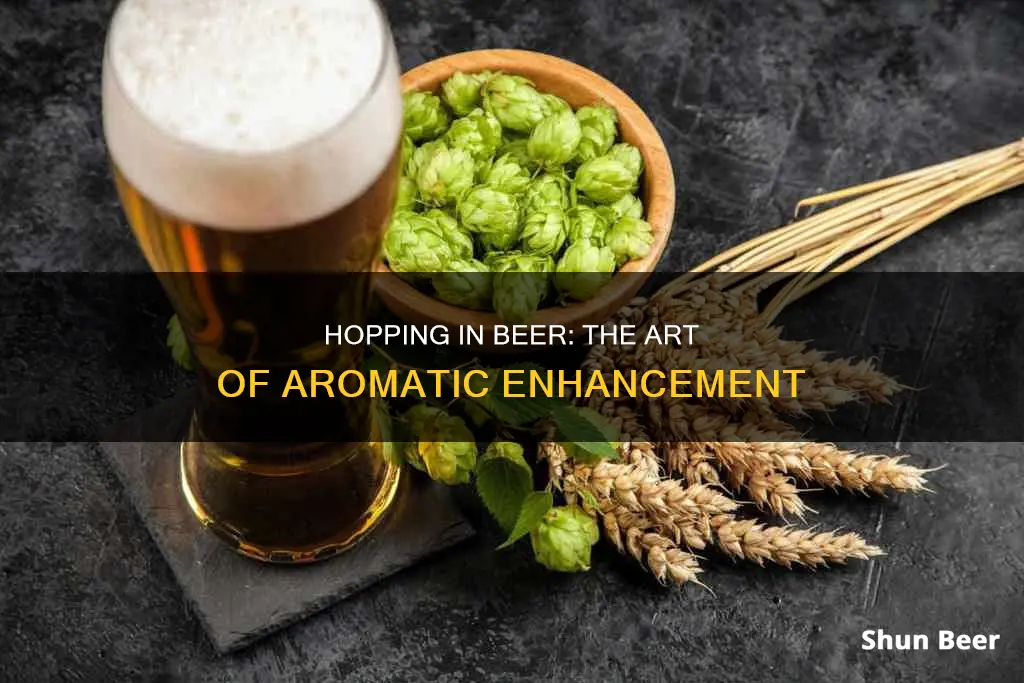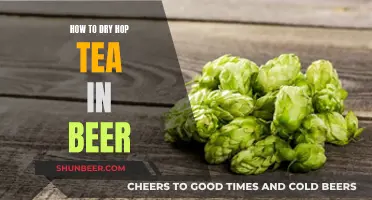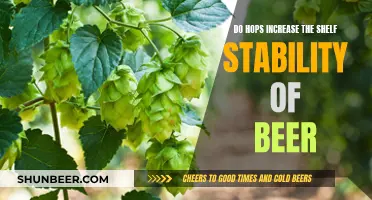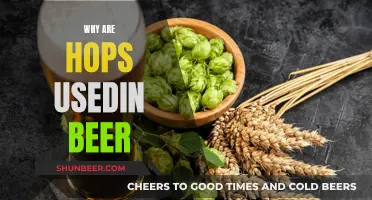
Hops are the flowers of the hop plant, Humulus lupulus, and are used as a bittering, flavouring, and stabilising agent in beer. The process of hopping involves adding hops at different stages of the brewing process to impart bitterness, flavour, and aroma to the beer. The term hopping refers to the different methods and timings of adding hops to the beer during brewing. The most common method is adding hops during the wort boil, with hops added earlier in the boil contributing more bitterness, and those added later infusing the beer with more aromatics. Dry hopping is a technique where hops are added during fermentation or conditioning, infusing the beer with fresh hop flavour and aroma without the bitterness. Wet hopping involves adding freshly picked hops during brewing, usually on the same day they are harvested, resulting in vivid aroma and flavour profiles with reduced bitterness.
What You'll Learn
- Hops are the flowers of the hop plant, Humulus lupulus, and are used to add bitterness, flavour and stability to beer
- Hops are added at different stages of the brewing process to control bitterness, flavour and aroma
- Dry hopping is a technique where hops are added during fermentation or conditioning to add flavour and aroma without extra bitterness
- Wet hopping involves adding freshly picked hops to beer at any point during the brewing process
- The hops plant has separate female and male plants, and only female plants are used for commercial production

Hops are the flowers of the hop plant, Humulus lupulus, and are used to add bitterness, flavour and stability to beer
Hops are the flowers of the hop plant, *Humulus lupulus*, and are used to add bitterness, flavour and stability to beer. They are also called seed cones or strobiles. The hop plant is a vigorous, climbing, herbaceous perennial, which is usually trained to grow up strings in a field. The first documented use of hops in beer was in the 9th century, though Hildegard of Bingen, 300 years later, is often cited as the earliest documented source. Hops are added to beer at different stages of the brewing process to achieve different results. The earlier the hops are added in the boil, the more bitterness they will impart. The latest additions are used for flavour and aroma.
Hops are added to beer to add bitterness, flavour, and stability. The bitterness comes from alpha acids, while flavour and aroma come mostly from volatile oils. The term volatile refers to the fact that the oils boil out of the wort relatively quickly — most within 15-20 minutes. This is why brewers normally add flavour and aroma hops closer to the end of the boil. Hops also have antibacterial effects, which help prevent spoilage.
The different methods of hopping include first wort hopping, mash hopping, using a hopback, and dry hopping. First wort hopping involves adding hops to the kettle before the boil begins, which is supposed to create a smoother and more balanced bitterness and a more complex hop aroma. Mash hopping involves adding hops to the mash to boost flavour and aroma, though its effectiveness is contested. A hopback is a device that flows hot wort in-line through a vessel containing a hop addition, which releases delicate oils that provide aroma and keep them locked in the wort as it is cooled.
Dry hopping is the addition of hops to beer during fermentation or conditioning, or in the serving vessel. It is used to infuse beer with additional fresh hop flavour and aroma. It is a cold infusion technique that intensifies hop aromatics in beer and adds aromatics that are substantially different from those achieved by late hopping. Dry hopping does not add bitterness to the beer, as boiling is necessary to convert the alpha acids in the hops to iso-alpha acids, which create bitterness.
The Perfect Blend: Hops and Grains in Beers
You may want to see also

Hops are added at different stages of the brewing process to control bitterness, flavour and aroma
Hops are the flowers of the hop plant, Humulus lupulus, and are used as a bittering, flavouring, and stabilising agent in beer. They are added at different stages of the brewing process to control bitterness, flavour, and aroma.
Hops are typically added to the wort in three stages during the boil: bittering, flavour, and aroma. However, some beers may have only one addition, while others may have up to five or six. All beers will have at least one hop addition for bitterness, to balance the sweetness of the malt.
The timing of hop additions is crucial as the longer hops are exposed to heat, the more likely they are to contribute bitterness rather than flavour. The early addition of hops results in more bitterness, while later additions are intended for flavour and aroma. The highly volatile hop oil components escape quickly during the boil, taking most of the aromatics with them.
Bittering hops are added once the wort has been collected in the kettle and a rolling boil has been achieved. They are usually boiled for 60 minutes but can be as little as 30 minutes. All beers have bittering hops to balance the sweetness of the malt and to act as a natural preservative.
Flavouring hops are generally added with between 15 and 30 minutes remaining in the boil. During this time, minimal bitterness is extracted, but a crisp hoppy flavour is imparted.
Aroma hops are added during the last 5 minutes of the boil or at flame-out when the kettle is removed from the heat. Aroma hops must not be boiled for long as the hop oils responsible for the aroma are extremely volatile and will be driven off in the steam. Adding hops at flame-out will produce the maximum amount of aroma.
In addition to these three stages, dry hopping is a technique where hops are added to the beer after the first part of fermentation is completed, shortly before packaging. Dry hopping is used to infuse the beer with additional fresh hop flavour and aroma without increasing bitterness.
Importing Azacca Hops to BeerSmith: A Step-by-Step Guide
You may want to see also

Dry hopping is a technique where hops are added during fermentation or conditioning to add flavour and aroma without extra bitterness
Dry hopping is a technique used by brewers to enhance the flavour and aroma of beer without adding extra bitterness. The process involves adding hops during fermentation or conditioning—the "cold side" of brewing—when ales and lagers are transferred from kettles to fermentation tanks.
Hops contain compounds called alpha acids, which contribute to the bitterness of beer when heated during the boil. This process, known as isomerization, increases the bitterness of the finished beer. However, dry hopping preserves the delicate volatile oils in hops that provide flavour and aroma, as these oils do not survive a boil. By adding hops during the cold side of brewing, brewers can amplify the aroma and flavour of their beers without extracting more bitterness.
The timing of dry hopping is crucial. Hops added earlier in the brewing process contribute more bitterness, while hops added later infuse the beer with more aromatics. Dry hopping is typically done during or after primary fermentation, with some brewers opting for multiple dry hops at different stages. The duration of dry hopping can vary, but it is generally recommended to keep hops in contact with the beer for 2-4 days to achieve optimal results.
Different forms of hops can be used for dry hopping, including dried whole leaf hops and T-90 pellets. Commercial breweries often prefer pellet hops due to their longer shelf life, efficiency, and lower beer absorption. The choice of hop variety also depends on the desired flavour profile of the beer, with aroma-forward hops being commonly used for dry hopping.
Dry hopping has evolved over the centuries, with British brewers originally using the technique to add hops to casks of matured beer to help preserve them during long journeys. Today, dry hopping is widely used by craft brewers to maximise the flavour and aroma of their beers, especially in popular styles like IPAs and pale ales.
Budweiser's Hoppy Taste: Beer Style Secrets Revealed
You may want to see also

Wet hopping involves adding freshly picked hops to beer at any point during the brewing process
Wet hopping is the process of using un-kilned, freshly picked hops in brewing. The term "wet" refers to the fact that these hops have not been dried out yet. In the Northern Hemisphere, hops are typically harvested in late August to early September, and wet hops are used on the same day they are harvested. Wet hops are approximately 80% moisture, so brewers must be careful to avoid mould and deterioration.
Wet hopping involves adding these freshly picked hops to beer at any point during the brewing process. Beers produced with un-kilned hops are often called "wet hop" beers, "fresh hop" beers, "green hop" beers, or "harvest" beers. These beers have become popular over the last decade, especially among American craft brewers located in hop-growing areas.
Wet hops can be added at any point in the boil, or into a hop-back. They are also increasingly being added to cool, finished beer, in a process known as "wet dry hopping". This technique aims to capture the hops' delicate and volatile aroma oils in the finished beer.
Wet hopping can add a uniquely "green" character to beers, with grassy, melon, pine, and grapefruit notes. However, brewers must be careful not to overdo it, as too much wet hopping can result in undesirable tobacco and chlorophyll notes.
Crafting Beer: Pounds of Hops for Perfect Brews
You may want to see also

The hops plant has separate female and male plants, and only female plants are used for commercial production
Hopping is a term used to describe the various methods of adding hops to beer during different stages of the brewing process. Hops are added to beer to impart bitterness, flavour, and stability. The hops plant, Humulus lupulus, has separate male and female plants, and only female plants are used for commercial beer production.
The hops plant is a climbing perennial, usually trained to grow up strings in a field. The reproduction method of the hops plant is such that male and female flowers develop on separate plants. The female flowers, commonly referred to as cones, contain the acids and essential oils that give beer its distinctive aroma and bitterness. Male plants produce pollen that can be carried by the wind to fertilise female cones, resulting in seeds. However, seeds in cones can negatively affect beer flavour stability, so only female plants are used in commercial beer production.
Male hops plants are very rare in the wild. In rare cases, female plants can show signs of male anatomy, but these plants are sterile and will not self-pollinate. If a male plant is located near a female plant, it could pollinate the female, causing the hop cones to have seeds. To avoid this, commercial growers remove male plants from their fields.
The use of hops in beer dates back to the 9th century, and they are primarily used as a bittering, flavouring, and stability agent. Hops are added at different stages of the brewing process, with each stage imparting unique characteristics to the final product. The early addition of hops results in more bitterness, while late hopping enhances the flavour and aroma.
Dry hopping is a technique where hops are added to the beer after the first vigorous part of fermentation, shortly before packaging. This method is commonly used in English pale ales and their variants, as well as American craft beers, to enhance the hop aroma and flavour.
The Ultimate Guide to Hops in Beer Brewing
You may want to see also
Frequently asked questions
Hops are the flowers (also called seed cones or strobiles) of the hop plant Humulus lupulus.
Hopping is the process of adding hops to beer during the brewing process.
There are several types of hopping, including dry hopping, wet hopping, first wort hopping, and mash hopping.
Dry hopping is typically done during fermentation or conditioning, while wet hopping involves adding freshly picked hops at any point during the brewing process. First wort hopping is done before the boil begins, and mash hopping involves adding hops to the mash.
Hopping adds "hoppy" aromas and flavors to beer, and can also add bitterness. It helps to keep beer fresh and retain its head of foam, which is a key component of a beer's aroma and flavor.







